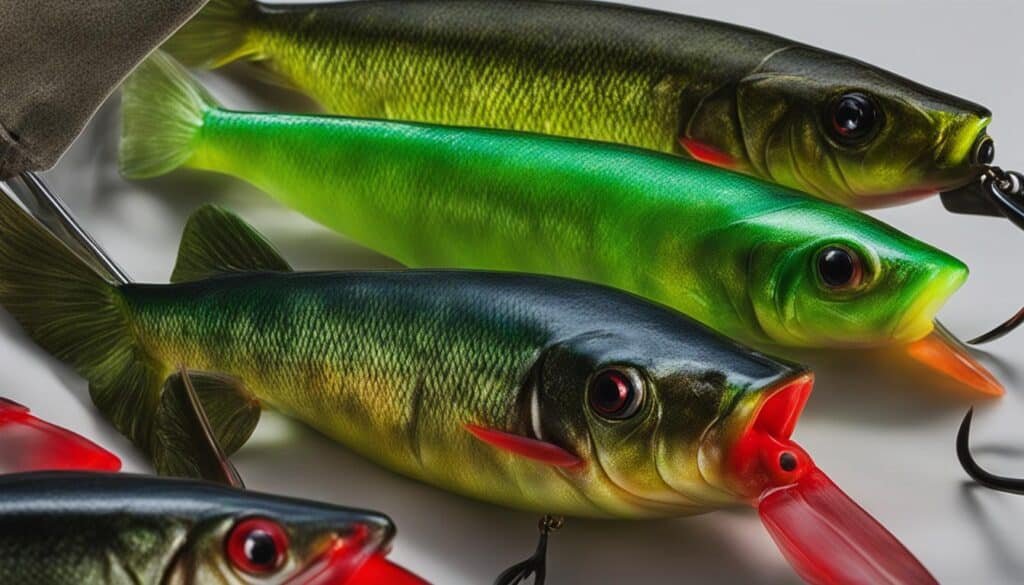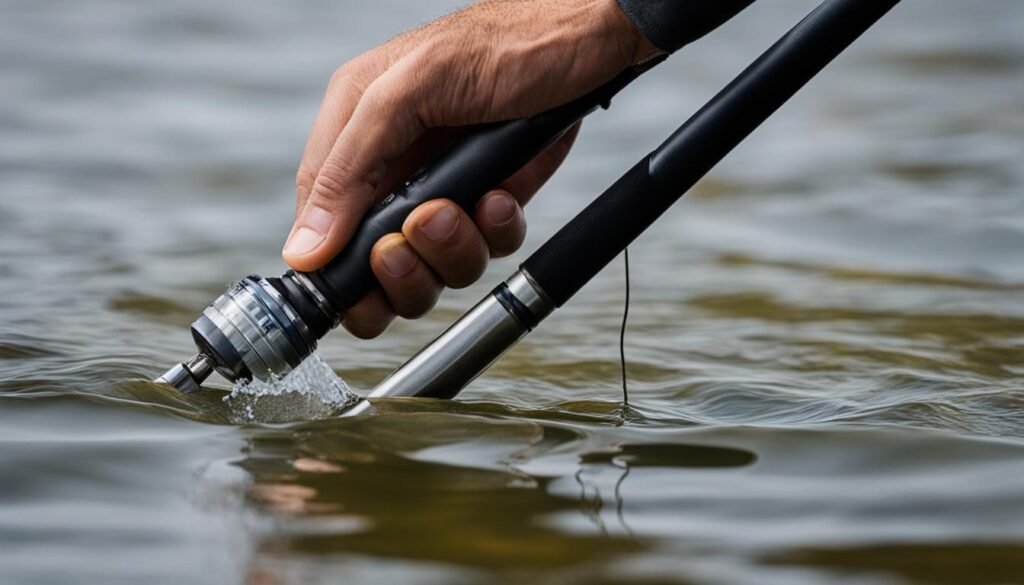Welcome to the Ultimate Guide to Texas Rig Fishing! Whether you’re a beginner or an experienced angler, this comprehensive resource will provide you with all the knowledge and skills you need to master the art of Texas rig fishing and catch more bass. From essential techniques and gear selection to advanced strategies and pro angler insights, we’ve got you covered.
But first, let’s understand why the Texas rig is such a popular and effective fishing technique. The Texas rig offers several advantages, including its ability to target bass in heavy cover, its versatility in presenting soft plastic baits, its weedless design to prevent snagging, and its effectiveness in mimicking natural prey.
- Why You Should Use The Texas Rig
- Decoding the Texas Rig: Components and Setup
- Essential Knots for a Reliable Texas Rig
- Choosing the Right Soft Plastic Bait for Your Texas Rig
- Mastering the Cast: Techniques to Maximize Your Texas Rig Effectiveness
- Adapting the Texas Rig for Different Environments
- Critical Tips for Detecting Bites and Setting the Hook
- Fishing Gear Essentials: Rods, Reels, and Line for Texas Rigging
- Seasonal Strategies: Optimizing the Texas Rig Through the Year
- Advanced Texas Rig Techniques: The Art of "Swimming" and "Carolina-Rigging"
- Pro Angler Insights: Fine-Tuning Your Texas Rig Approach
Why You Should Use The Texas Rig
The Texas rig is a highly effective fishing technique that has been proven to catch bass in various conditions. There are several reasons why anglers should consider using the Texas rig:
- Target Bass in Heavy Cover: The Texas rig’s weedless design allows you to fish in dense vegetation, laydowns, and other areas where bass seek shelter. This technique enables you to effectively present your bait to bass in hard-to-reach places, increasing your chances of getting a bite.
- Versatility in Presenting Soft Plastic Baits: With the Texas rig, you can use a wide variety of soft plastic baits, such as worms, creatures, craws, and swimbaits. This versatility allows you to adapt your bait selection to match the conditions and the preferences of the bass you’re targeting.
- Weedless Design to Prevent Snagging: One of the main advantages of the Texas rig is its weedless design. The bullet sinker is rigged to the line, protecting the hook and bait from getting caught in weeds, rocks, or other underwater obstructions. This makes it an ideal rig for fishing in areas with heavy cover.
- Imitates Natural Prey: The Texas rig excels at imitating the natural movement and behavior of baitfish, crawfish, and other bass prey. With the right presentation and bait selection, you can effectively mimic the prey that bass are actively feeding on, triggering their predatory instincts and enticing them to strike.
By using the Texas rig, you can increase your chances of landing more bass and enjoying a successful fishing trip. Whether you’re targeting bass in heavy cover, presenting soft plastic baits, avoiding snagging, or imitating natural prey, the Texas rig is a versatile and reliable technique that should be a staple in every angler’s arsenal.
Advantages of the Texas Rig
- Target bass in heavy cover
- Versatile presentation of soft plastic baits
- Weedless design prevents snagging
- Effective in imitating natural prey
Decoding the Texas Rig: Components and Setup
Mastering the Texas rig fishing technique begins with understanding its components and the proper setup. The Texas rig is composed of three main elements: the bullet sinker, the offset worm hook, and the soft plastic bait. Let’s take a closer look at each component and how they come together to create an effective fishing rig.
The Anatomy of a Texas Rig Setup
The first component of the Texas rig is the bullet sinker. The bullet sinker is designed to slide freely on the fishing line and provides the weight needed to cast the rig and get it down to the desired depth. The weight of the sinker can vary depending on the fishing conditions and the depth you want to target.
The second component is the offset worm hook. The offset worm hook is specially designed with a curved shape that helps to secure the soft plastic bait and increases hook-up ratios. It is important to select the proper size and style of offset worm hook based on the size and type of soft plastic bait you will be using.
The final component is the soft plastic bait. This can be a plastic worm, creature bait, or other types of soft plastics that imitate natural prey. The soft plastic bait is rigged onto the offset worm hook in a specific manner to ensure a natural presentation and weedless design.
Selecting the Proper Offset Worm Hook
When selecting the offset worm hook for your Texas rig, consider the size and style that best matches the soft plastic bait you will be using. The hook should be large enough to accommodate the bait, but not too large that it hinders the bait’s action or causes it to tear easily. Experiment with different hook sizes until you find the one that provides the best balance and hooking efficiency.
Understanding Bullet Sinkers and Their Impact on Presentation
The weight of the bullet sinker determines the rate at which your Texas rig sinks and how it presents to the fish. Heavier sinkers allow for faster sink rates and can be more effective in deeper water or stronger currents. Lighter sinkers are better suited for shallower water or when a more subtle presentation is desired. The shape of the bullet sinker also plays a role in how your rig moves through cover and structures, as well as its ability to resist snagging.
Advanced Setup: When and How to Peg Your Weight
In certain fishing situations, anglers may choose to “peg” their weight to the line. This involves using a toothpick or a specialized weight pegging device to secure the sinker in place, close to the hook. Pegging the weight can help prevent the sinker from sliding up and down the line, allowing for a more compact presentation and reducing the chances of snagging. In heavy cover or when fishing in vegetation, pegging the weight can be a valuable technique to consider.
Essential Knots for a Reliable Texas Rig
Knots play a crucial role in setting up and fishing with the Texas rig. As an angler, it’s important to know and master essential knots that will ensure the reliability of your Texas rig setup. Two essential knots that are commonly used are the Palomar knot and the uni-knot.
The Palomar knot is known for its strength and ease of use. It is ideal for attaching the hook, sinker, or bait onto the line. To tie the Palomar knot, follow these steps:
- Double about 6 inches of line and pass it through the eye of the hook, sinker, or bait.
- Tie a simple overhand knot, forming a loop with both ends of the line.
- Pass the loop over the hook, sinker, or bait.
- Moisten the knot and pull on both ends of the line to tighten it.
The uni-knot is another versatile knot that is commonly used in fishing. It is easy to tie and provides good knot strength. To tie the uni-knot, follow these steps:
- Pass the line through the eye of the hook, sinker, or bait, and fold it back parallel to the standing line.
- Create a loop by wrapping the tag end around the standing line for 4-6 turns, moving away from the hook.
- Thread the tag end through the loop above the eye of the hook, sinker, or bait.
- Moisten the knot and tighten it by pulling on the tag end and standing line.
Choosing the Right Soft Plastic Bait for Your Texas Rig

The success of your Texas rig greatly depends on selecting the right soft plastic bait. With a wide range of options available, it’s essential to choose baits that will attract and entice bass. Here are some popular choices:
Worms: The Quintessential Bass Lure
When it comes to bass fishing, worms are considered the quintessential bait for a Texas rig. Worms come in various sizes, colors, and styles, allowing you to match the hatch and target specific bass feeding patterns. Whether you prefer straight worms, curly-tail worms, or ribbon tail worms, make sure to have a diverse selection to cover different water conditions and preferences of the bass.
Creatures and Craws: Adding Dimension to Your Rig
Creatures and craws are another popular choice for adding dimension and attractants to your Texas rig. These baits mimic small aquatic creatures that bass feed on, such as crayfish and creatures found in weed beds or along the bottom. The appendages and lifelike movement of creatures and craws can trigger aggressive strikes from bass actively looking for prey.
Swimbaits and Flukes: Mastering the Subtle Action
If you’re looking to emulate the subtle action of injured baitfish or want to imitate a swimming prey, swimbaits and flukes are the way to go. These soft plastic baits have a realistic swimming action that can entice bass into striking. Swimbaits are great for slow retrieves and imitating injured shad, while flukes excel when you want to cover water quickly with a fast, erratic retrieve.
Mastering the Cast: Techniques to Maximize Your Texas Rig Effectiveness
The cast is a fundamental technique in Texas rig fishing that can greatly impact your effectiveness. There are several casting techniques that anglers can master to maximize their Texas rig’s effectiveness, including the overhead cast, sidearm cast, and pitching. Each technique has its advantages and is useful in different fishing scenarios. By mastering the cast, you can accurately and efficiently present your Texas rig to potential bass, increasing your chances of getting a bite.
One of the most common casting techniques in Texas rig fishing is the overhead cast. To perform this cast, start by holding your rod above your head with the reel facing downwards. Pull the rod back behind your shoulder and then swiftly forward, releasing the line at the right moment to propel your bait towards your desired target. The overhead cast allows for great casting distance, making it ideal for open-water situations or when you need to cover a large area.
Another effective casting technique for Texas rig fishing is the sidearm cast. This cast involves holding your rod at a horizontal angle, close to your body. With a smooth motion, bring the rod forward, releasing the line to propel your bait towards your target. The sidearm cast is particularly useful when you need to cast under low-hanging vegetation or when you want to make precise casts to specific targets.
Pitching is a specialized casting technique that requires finesse and accuracy. It involves swinging your rod forward, releasing the line with a controlled motion, and aiming your bait towards your target. Pitching is ideal for fishing in tight spaces, such as around docks, vegetation, or other structures where traditional casting techniques may be challenging. By mastering pitching, you can effectively present your Texas rig in areas where bass are likely to be hiding or feeding.
Adapting the Texas Rig for Different Environments
The Texas rig can be adapted to different fishing environments to increase its effectiveness. Anglers should understand how to fish the Texas rig in weed beds, rocky terrain, and open water.
Weed Beds: The Texas Rig’s Natural Habitat
In weed beds, the Texas rig shines as it can navigate through vegetation without snagging, providing a natural presentation to bass.
Rocky Terrain: Adjustments for a Snag-Free Experience
In rocky terrain, adjustments to the rig’s components and weight placement can help minimize snags and maximize fishing time.
Open Water: How to Cover More Water with the Texas Rig
In open water, anglers can cover more water by using techniques such as dragging, hopping, and swimming the Texas rig.
Critical Tips for Detecting Bites and Setting the Hook

When Texas rig fishing, honing your skills in detecting bites and setting the hook can significantly improve your success rate. By paying attention to subtle cues and employing proper techniques, you can increase your chances of hooking that trophy bass.
One essential tip for detecting bites is to be vigilant about line movement, slack, and vibrations. Keep a close eye on your fishing line for any twitches, sudden movements, or slight vibrations that indicate a potential bite. These subtle signals can be easy to miss, so stay focused and alert.
Once you detect a bite, setting the hook promptly and with the right amount of force is crucial. There are a few techniques you can use to achieve a solid hookset. The sweep set is a common method where you sweep the rod to the side, using a smooth and controlled motion to drive the hook home. Another technique is the reel set, where you rely on the reel’s drag system to set the hook while reeling in the line. Experiment with these techniques to find the one that works best for you and the specific fishing situation.
An important aspect of setting the hook is to avoid excessive force. While it’s tempting to yank the rod with all your might, doing so can often result in a lost fish. Instead, apply a firm and steady pressure without jerking the rod too aggressively. This allows the hook to penetrate the bass’s mouth and secure a solid hookset.
Fishing Gear Essentials: Rods, Reels, and Line for Texas Rigging
When it comes to Texas rig fishing, having the right gear is essential. The right rods, reels, and fishing line can make a significant difference in your success on the water. Let’s explore the key factors to consider when selecting your fishing gear for Texas rigging.
The Best Rod Length and Action for Bass Fishing
Choosing the right rod for Texas rig fishing is crucial. A rod with the appropriate length and action will allow for accurate casts, improved sensitivity, and better hook-setting power.
For most bass fishing scenarios, a medium to medium-heavy rod with a length between 6’6″ and 7’6″ is ideal. This length provides a good balance of casting distance and control. Additionally, a fast or extra-fast action rod will provide the necessary sensitivity to detect subtle bites and set the hook effectively.
Choosing a Reel to Complement Your Texas Rig Technique
When selecting a reel for Texas rig fishing, consider the gear ratio and line capacity. A reel with a gear ratio between 6.3:1 and 7.3:1 will provide a good balance of speed and torque for working your Texas rig effectively.
In terms of line capacity, choose a reel that can handle at least 150 yards of fishing line. This will ensure that you have enough line to make long casts and handle any potential big bass that strike your Texas rig.
Fluorocarbon vs. Braided Line: Making an Informed Choice
When it comes to choosing the right fishing line for Texas rigging, anglers often debate between fluorocarbon and braided line.
Fluorocarbon line is known for its low visibility underwater, making it an excellent choice for clear water conditions. It also has good sensitivity, allowing you to detect subtle bites. On the other hand, braided line offers exceptional strength and abrasion resistance, making it suitable for fishing in heavy cover.
Ultimately, the choice between fluorocarbon and braided line depends on your fishing preferences and the specific conditions you’ll be fishing in. Experiment with both types of line to determine which one works best for you and your Texas rig setup.
Seasonal Strategies: Optimizing the Texas Rig Through the Year

The Texas rig is a versatile fishing technique that can be optimized throughout the year to increase your chances of success. By understanding the impact of seasonal factors such as water temperature, bass behavior, and baitfish activity, you can make adjustments to your Texas rig approach and attract more bass.
During colder months, when water temperatures are lower, bass tend to be less active. To entice them, consider using lighter colored baits that mimic the prey’s natural appearance in colder water. This can make your Texas rig stand out and increase its visibility to bass. Additionally, slowing down your retrieval speed can be beneficial in colder water, as it gives bass more time to identify and strike your bait.
In contrast, warmer months bring increased bass activity and a faster metabolism. As a result, you may want to adjust your Texas rig by using darker colored baits that create a contrast against the water and attract the attention of active bass. Additionally, increasing your retrieval speed can help trigger reaction bites from bass that are actively feeding.
Seasonal Strategies for Optimal Texas Rig Fishing
| Season | Water Temperature | Bass Behavior | Baitfish Activity | Texas Rig Optimization |
|---|---|---|---|---|
| Winter | Colder | Less active | Decreased | Lighter colored baits, slower retrieval speed |
| Spring | Warming up | Increasing activity | Starting to spawn | Natural and vibrant colored baits, medium retrieval speed |
| Summer | Warm | Highly active | Peak activity | Darker colored baits, faster retrieval speed |
| Fall | Cooling down | Transitioning | Feeding heavily | Natural and vibrant colored baits, varied retrieval speed |
Advanced Texas Rig Techniques: The Art of “Swimming” and “Carolina-Rigging”
Beyond the basic Texas rig setup, anglers can explore advanced techniques to enhance their bass fishing skills. Two popular techniques to consider are swimming a Texas rig and Carolina-rigging. These techniques add versatility and increase the chances of catching bass in different fishing scenarios.
The Subtle Art of Swimming a Texas Rig
Swimming a Texas rig involves imparting a subtle action to the bait, mimicking the movement of a swimming prey. This technique is effective in enticing bass during various conditions. To swim a Texas rig, use a soft plastic bait that has a natural swimming action, such as a paddle-tail worm or a swimbait.
Cast your rig into the water and let it sink to the desired depth. Once it reaches the target area, retrieve the bait with a rhythmic, steady motion, imitating the movement of a swimming baitfish. Vary the retrieval speed and use rod twitches or pauses to create subtle movements that catch the attention of bass.
Carolina-Rigging a Texas Rig for Deeper Insights
Carolina-rigging combines the effective Texas rig with a leader and a bead, allowing for controlled depth presentation and increased sensitivity. This technique is particularly useful when fishing in deeper waters or when bass are holding near the bottom. Carolina-rigging provides a different presentation and can help locate bass that are not responding to other techniques.
To Carolina-rig a Texas rig, start by tying a hook onto a leader line. Slide a bead onto the mainline before attaching a swivel. Connect the leader to the swivel, and then tie the mainline to the other end of the swivel. This setup allows the bait to move freely and provides a subtle clicking sound as the bead taps against the swivel, attracting curious bass.
Cast the Carolina-rigged Texas rig and allow it to sink to the desired depth. Once the rig reaches the bottom, use a slow and steady retrieve, dragging the bait along the bottom while maintaining contact with it. Pay attention to any changes in weight or movements, as this could indicate a bite. When a bass strikes, give it a moment to fully take the bait before setting the hook with a firm but controlled motion.
| Advanced Texas Rig Techniques | Description |
|---|---|
| Swimming a Texas Rig | Impart a subtle action to the bait, mimicking the movement of a swimming prey. Effective in various conditions, especially with soft plastic baits with a natural swimming action. |
| Carolina-Rigging a Texas Rig | Combine the Texas rig with a leader and a bead for controlled depth presentation and increased sensitivity. Ideal for fishing in deeper waters and when bass are holding near the bottom. |
Pro Angler Insights: Fine-Tuning Your Texas Rig Approach
When it comes to mastering the art of Texas rig fishing, there’s no better source of knowledge than the pro anglers who have honed their skills through years of experience and countless hours on the water. These seasoned experts have valuable insights and tips that can help you fine-tune your Texas rig approach and elevate your fishing game.
Pro anglers often emphasize the importance of making adjustments to key elements of your Texas rig setup. Hook size is one aspect that can make a significant difference in your success rate. Depending on the size of the bass you’re targeting, you may need to experiment with different hook sizes to find the perfect balance between hooking power and bait presentation.
Bait selection is another area where pro angler insights can be invaluable. Experienced anglers often have a repertoire of go-to soft plastic baits that consistently produce results. Trying different colors, sizes, and styles, based on their recommendations, can help you identify the baits that bass are most responsive to in your fishing area.
Retrieval techniques and fishing strategies are also areas where pro anglers can offer valuable guidance. They may share tips on how to manipulate your bait to trigger strikes, such as adding subtle twitches or pauses to your retrieve. Additionally, pro anglers may advise on the best times to fish certain areas or the most effective strategies for targeting bass in specific conditions.

